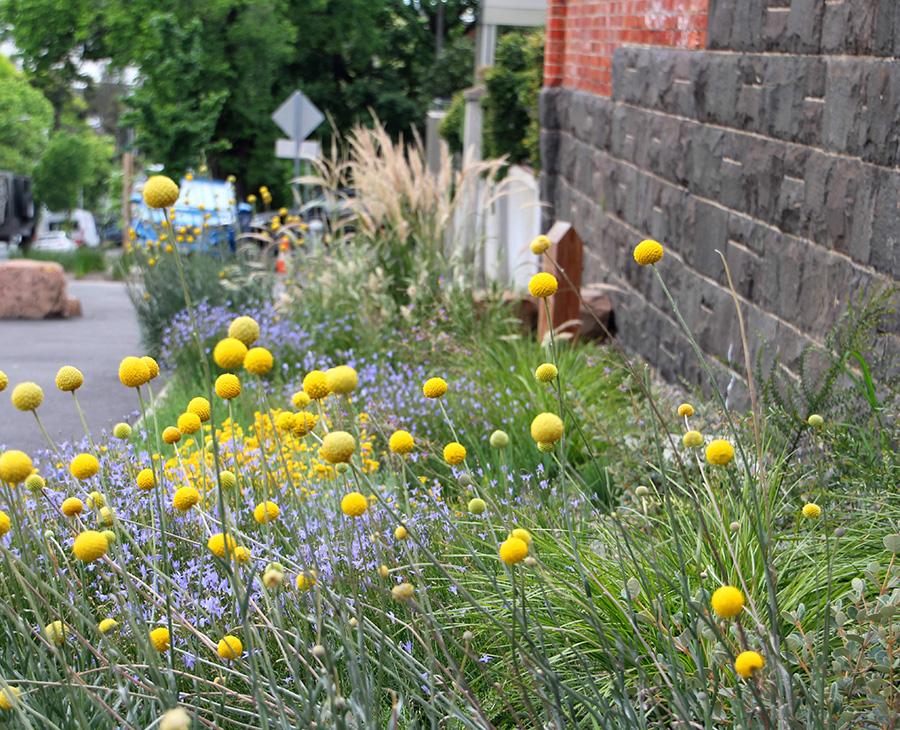Located in between two 1970’s apartment buildings in East Melbourne, the site represented one of the few opportunities to green a significant parcel of land in the Jolimont area.
Now, residents and the wider community have access to a new and inviting garden space to enjoy.
The existing condition of the communal open space area was stark and bare – void of soft landscaping with the exception of a small garden bed located along the eastern boundary. During the summer months, the large expanses of concrete and masonry collected and radiated heat from the summer sun, substantially increasing the temperature of the forecourt and adjacent residences. The hard surfaces further amplified noise and glare.
With support from the Urban Forest Fund, the area has been transformed. Twenty one custom made square and rectangular planter boxes now pinwheel along the length of the forecourt. Weight load has been taken into consideration given the garden has been created on an existing concrete roof with a semi-basement car park below. A new irrigation system has been integrated into the design to support the viability of the plants.
The new garden will increase its total green cover in the common open space area by 43.81 per cent, comprising 183.3 square metres of total green cover including 138 square metres of tree canopy cover.
Species selection has been guided by various inputs including a qualified landscape architect, and a visit from volunteer garden guides from Gardens for Wildlife Melbourne. The garden has been planted with native and indigenous plant species that offer habitat resources for local native birdlife and insects.
The new greenery will assist in reducing the 'heat island effect', buffer noise, and reduce glare experienced by its users, offering new spaces to gather for residents and the public alike.
Although the garden at 22 Agnes Street East Melbourne is located on private space, it is publicly accessible. The garden is not fenced and visitors are welcome to visit the garden.
The project was completed in December 2022 and plants are establishing well.
Environment and biodiversity benefits
- The garden has created 183 square metres of new green cover, including 138 square metres in tree canopy cover.
Plants are all native or indigenous, and have been selected to promote biodiversity and provide food and habitat for local wildlife, particularly birds and bees. This includes species such as:
Trees: coastal banksia (Banksia integrifolia) and coral gum (Eucalyptus torquata)
Shrubs: nodding saltbush (Einadia nutans) and common correa (Corra reflexa)
Tussock-forming plants: Lomandra and Dianella species
Wildflowers/groundcovers: common everlasting (Chrysocephalum apiculatum) and rounded noon-flower (Disphyma crassifolium)
- Replacement of existing concrete to vegetated areas will assist in reducing the 'heat island effect', buffer noise, improve air quality and reduce glare experienced by its users.
Community benefits
- This resident-led greening initiative will bring the local community together, support environmental stewardship amongst each other, and provide opportunities for more social interactions through garden maintenance working bees and outdoor gatherings.
- New green space will improve amenity for residents and enhance visual appeal of the area.
- The garden will connect residents and locals, increasing opportunities to engage, and be immersed with nature.

Site before greening works, taken September 2022
Photo: David Hannah

Site after greening works, taken April 2023
Photo: David Hannah

Site before greening works, taken September 2022
Photo: David Hannah

Site after greening works, taken April 2023
Photo: David Hannah

Site before greening works, taken September 2022
Photo: David Hannah

Site after greening works, taken April 2023
Photo: David Hannah

Site before greening works, taken September 2022
Photo: David Hannah

Site after greening works, taken April 2023
Photo: David Hannah

Site before greening works, taken September 2022
Photo: David Hannah

Site after greening works, taken April 2023
Photo: David Hannah

Site before greening works, taken September 2022
Photo: David Hannah

Site after greening works, taken April 2023
Photo: David Hannah






